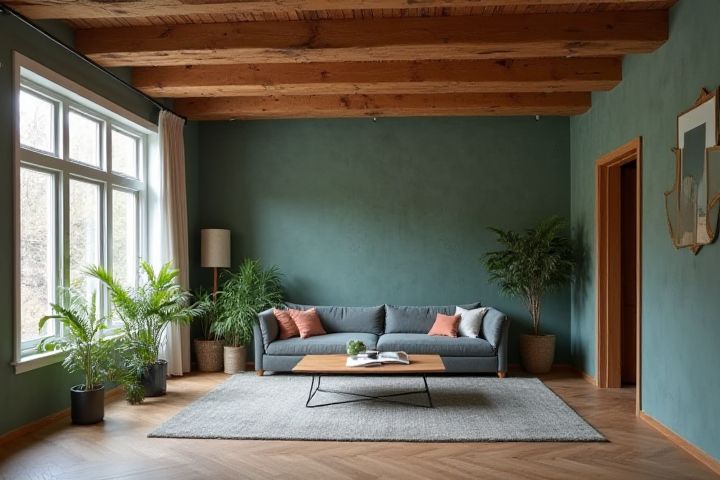
To effectively soundproof a house, focus on sealing gaps and cracks in walls, windows, and doors with acoustic caulk or weatherstripping, which prevents sound leakage. Investing in soundproofing materials, such as mass-loaded vinyl or soundproof drywall, can significantly enhance the sound barrier within your home. You can also install sound-absorbing panels made from foam or fabric on walls and ceilings to minimize echo and background noise. Adding heavy curtains or soundproof blinds to windows not only improves aesthetics but also reduces external noise intrusion. For more impact, consider isolating floors with carpets or rugs and using rubber mats beneath appliances to dampen vibrations.
How To Soundproof A House
Seal gaps and cracks
Sealing gaps and cracks is crucial for effective soundproofing; even small openings can let sound waves permeate your home. Use acoustical caulk, which is specially designed to block sound transmission, to fill gaps around windows, doors, and any wall penetrations, such as electrical outlets and pipes. Ensure that you also pay attention to baseboards and crown molding, as these are often overlooked areas where sound can escape. Properly sealing these vulnerabilities can significantly reduce noise levels, making your living space more tranquil and comfortable.
Install soundproof curtains
Installing soundproof curtains can significantly reduce noise infiltration in your home. These specialized curtains are typically made from thick, heavy fabrics designed to block sound waves effectively, achieving up to a 50% reduction in noise. To maximize their soundproofing capabilities, ensure that the curtains cover the entire window area, extending several inches beyond the frame to prevent sound leaks. You can enhance the effectiveness of your soundproof curtains by pairing them with additional soundproofing methods, such as acoustic panels or sealing any gaps around windows and doors.
Use acoustic panels
Acoustic panels are a highly effective solution for soundproofing your house, as they absorb sound waves and reduce echo within a room. To optimize results, strategically place these panels on walls, ceilings, and even corners, focusing on areas where sound tends to bounce the most. For maximum impact, choose high-density foam or fabric-wrapped panels, as they offer superior sound absorption qualities while enhancing your interior decor. Incorporating acoustic panels into your home not only minimizes noise disturbance but also contributes to a more serene living environment.
Add carpets or rugs
Adding carpets or rugs effectively reduces noise levels within your home by absorbing sound waves. A thick, plush carpet can decrease sound transmission by up to 30%, creating a more serene environment. Placing rugs in high-traffic areas or under furniture can dampen footsteps and minimize echoes. Consider selecting carpets with dense fibers, as they offer superior soundproofing properties compared to thinner options.
Implement door sweeps
Implementing door sweeps is an effective method to enhance soundproofing in your house. These strips, installed at the bottom of interior and exterior doors, create a seal that prevents noise from entering or escaping between rooms and from outside. Choose materials like silicone or rubber for optimal sound absorption, ensuring that the sweep fits snugly against the floor. Regular maintenance, such as checking for wear and replacing worn sweeps, will help maintain their effectiveness in soundproofing your living space.
Upgrade windows for noise reduction
Upgrading your windows is a highly effective way to reduce noise pollution in your home. Consider installing double-glazed or triple-glazed windows, which consist of multiple layers of glass separated by insulating gas, significantly lowering sound transmission. You can also explore options like laminated glass, which contains a layer of plastic that helps dampen sound vibrations. Ensuring proper sealing around windows with weather stripping or acoustic caulk is crucial to eliminate any gaps that may allow noise infiltration.
Use soundproofing paint
Soundproofing paint is an innovative solution that can significantly reduce noise infiltration in your home. Typically, this specialized paint contains sound-deadening materials, such as rubber particles, which help absorb sound waves, making it a viable option for areas prone to noise disturbances. When applying soundproofing paint, it is essential to cover the entire surface area, including walls and ceilings, and consider using multiple coats for optimal effectiveness; one gallon can cover around 100 square feet per coat. For best results, combine this approach with other soundproofing methods, such as using acoustic panels or sealing gaps, to create a quieter living environment.
Incorporate mass-loaded vinyl
Incorporate mass-loaded vinyl (MLV) to significantly enhance your home's soundproofing capabilities, as it is an effective, dense material designed to block sound transmission. This specialized barrier can add up to 1 pound per square foot, making it a superior addition for both walls and ceilings. To achieve optimal results, apply MLV by attaching it directly to existing structures or using it as an underlayment beneath drywall or flooring materials. Combining MLV with other soundproofing methods, such as acoustic caulk and resilient channels, can further reduce unwanted noise, creating a quieter living environment for you and your family.
Add weather stripping
Weather stripping is an effective method to soundproof your house by creating a tight seal around doors and windows, preventing noise from entering or escaping. This material comes in various forms, including adhesive strips and foam, allowing you to choose the type that fits your needs best. Proper installation involves cleaning the surfaces thoroughly before applying the weather stripping, ensuring maximum adhesion and effectiveness against sound infiltration. You can significantly enhance your home's acoustics and comfort by sealing these gaps and cracks.
Implement soundproof insulation
Implementing soundproof insulation is essential for reducing noise pollution in your house. High-performance materials like acoustic foam panels, mineral wool, or fiberglass can significantly improve sound attenuation, with mineral wool boasting an STC (Sound Transmission Class) rating of up to 50. You can enhance effectiveness by adding resilient channels or soundproof drywall, which absorb vibrations and prevent sound leakage through walls. Engaging a professional contractor to strategically place these materials in critical areas can ensure your living spaces are quieter and more serene.
